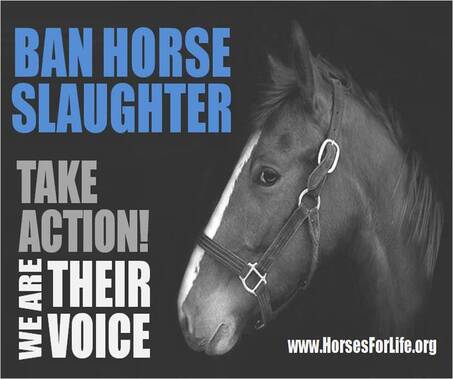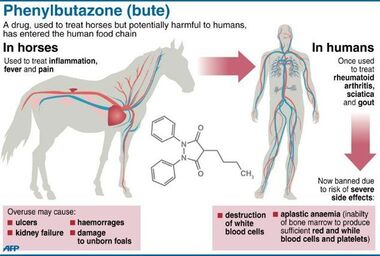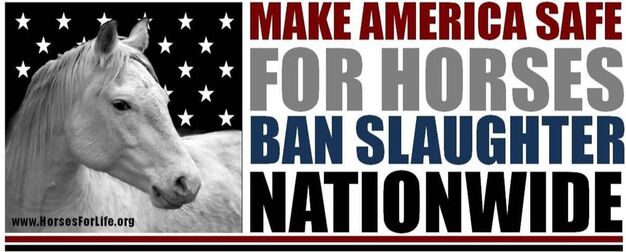WHY BAN HORSE SLAUGHTER?Horse slaughter is not only inhumane, it’s also life-threatening for people and destructive to communities. Extensive information compiled by the Animal Law Coalition details the well researched reasons why horse slaughter should be ended once and for all.
PUBLIC OPPOSITIONA nationwide poll conducted by Lake Research Partners confirms that 80% of Americans, regardless of their gender, political affiliation, whether they live in an urban or rural area, or their geographic location, oppose the slaughter of horses for human consumption. The poll confirms that a vast majority of horse owners are also against the slaughtering of our nation's equines. This poll is consistent with polls taken since 2006,
UNWANTED HORSE MYTHHorses purchased for slaughter are not old, disabled or "unwanted". The US Dept. of Agriculture has confirmed that 92.3% of the horses sent to slaughter are healthy. They could continue to be productive. Slaughter proponents have widely claimed that slaughter is somehow an alternative for "unwanted" horses. Nothing could be further from the truth. Slaughter actually creates a salvage or secondary market that enables overbreeding and poor breeding practices. Slaughter and a poor economy have resulted in horses in need. Slaughter is driven by a demand for horsemeat in foreign countries; it is not a "service" for unwanted horses and that is why most horses are healthy when they are sent to slaughter. Kill buyers are interested in buying the healthiest horses for horsemeat that is sold as a delicacy in some foreign countries.
Slaughter accounts for only about 3 cents for every $100 of the equine industry. It makes no sense for anyone to suggest a limited salvage market could influence prices in the entire horse industry. According to former U.S. Sen. Trent Lott (R-MS), the live horse industry is valued at $112.1 billion of gross domestic product, meaning the reabsorption of "surplus" horses not sent to slaughter would actually boost the economy.
AN INHUMANE DEATHEquine slaughter is not humane euthanasia. The slaughter of horses and other equines simply cannot be made humane: Dr. Lester Friedlander, DVM and former Chief USDA Inspector, told Congress in 2008 that the captive bolt used to slaughter horses is simply not effective. Horses and other equines, in particular, are very sensitive about anything coming towards their heads and cannot be restrained as required for effective stunning. Dr. Friedlander stated, "These animals regain consciousness 30 seconds after being struck, they are fully aware they are being vivisected." The Government Accountability Office and dozens of veterinarians and other witnesses have confirmed that ineffective stunning is common and animals are conscious during slaughter. It is simply not possible for USDA/APHIS to make equine slaughter humane and it is a myth to pretend otherwise.
FINANCIALLY IRRESPONSIBLEApproximately $5,000,000 of American taxpayer funds, in the form of USDA meat inspectors, was spent annually to subsidize the three foreign-owned (Belgian and French) horse slaughterhouses that operated in the U.S. until 2007. Because there is no market for horsemeat in the U.S., after slaughter, the meat was shipped overseas, and there was no benefit at all to the U.S. economy. Only the foreign owners and distributors profited. If these foreign-owned horse slaughterhouses are allowed to re-open, they would again be subsidized by American taxpayer money. Estimates are that the U.S. government would spend at least $3,000,000-5,000,000 to subsidize private horse slaughter facilities.
On top of that, the USDA could give foreign owners of U.S. horse slaughter facilities, such as Bouvry, the Canadian company that has explored the possibility of opening a horse slaughter house near Stanwood, Washington, or the Belgian company, Chevideco, which is planning to build a horse slaughter house in Oregon or Missouri, a subsidized loan of $750,000 through the RUS World Utilities Services. It is outrageous that the American taxpayer should support wealthy foreign investors in a business that profits from animal cruelty, benefits only foreign interests and wrecks the U.S. communities where the facilities are located. This money would surely be much better spent on American interests. Chevidico which owned Dallas Crown, which operated in Kaufman, Texas until 2007 paid each year only 1/3 of 1% of revenues in taxes; on year, for example, the horse slaughter house paid a total of $5.00 in federal taxes on $12,000,000 in annual sales.
Horses receive multiple medications, such as steroids, dewormers, and ointments, throughout their lives. The FDA bans the nonsteroidal anti-inflammatory drug (NSAID) Phenylbutazone (Bute) in all food-producing animals. Most horses have received bute, which is a carcinogen and can cause aplastic anemia and other health conditions in humans.
DEVASTATES COMMUNITIESEquine slaughter has been devastating to the communities where slaughtering facilities have been located, with significant negative impacts including nuisance odors that permeated the surrounding towns to chronic sewer and environmental violations. Blood literally ran in the streets and waste from the facilities clogged sewers and piled up everywhere. This predatory practice produced few very low wage jobs, meaning workers and their families overran local resources like the hospitals and government services. Horse slaughter brought in virtually no tax revenues and local governments incurred substantial enforcement costs in trying to regulate these facilities. The standard of living in these communities dropped during the time horse slaughter facilities operated. Good businesses refused to relocate there. As Paula Bacon, mayor of Kaufman, Texas during the time a horse facility operated there until 2007 said, "My community did not benefit. We paid."
When officials in Hardin, Montana learned of a plan to build horse facilities in that state, the town council immediately unanimously passed Ordinance No. 2010-01 that prohibits the slaughter of more than 25 animals in a seven day period. And in Mountain Grove, Missouri residents voted overwhelmingly against a horse slaughter plant in their community. The message is clear: Americans don't want equine slaughter. ENVIRONMENTAL IMPACTSAlthough animal blood is often used for dry blood mill, the antibiotics given to American horses prevent blood from breaking down; therefore, horse blood cannot be used for this purpose and blood and other organs cannot be used for any purpose. Communities will be required to find a way to dispose of horse blood, internal organs and waste. Horses have 1.74 times as much blood per pound of body weight as cows and with the drugs, it is harder to treat because the antibiotics in the blood kill bacteria used in the treatment process. This does not include the 15 million gallons of fecal material per year that must be handled. Note the Canadian horse slaughterhouse at Natural Valley Farms in Saskatchewan that was shut down in 2009 for dumping blood and tons of other waste into a local river or onto the ground.
HORSE THEFTAnother cost to communities is horse theft. Slaughterhouses know horses are stolen and brought to slaughter. Because horse slaughter is driven by a demand for horse meat in some foreign countries where it is a delicacy, horse slaughterers look for the healthiest horses, not abandoned, abused or neglected horses. When California banned horse slaughter in 1998, horse theft fell by 39.5% and in the years that followed, the state noted a nearly 88% decrease in horse theft. What does that tell you about this sleazy, brutal practice?
A LINK TO OTHER CRIMESIt is no surprise that following the closing of the horse slaughter plant, Kaufman residents enjoyed a significant decrease in virtually every type of crime. A recent study by a University of Windsor criminologist, Amy Fitzgerald, shows a link between slaughterhouses and violent crime. Last year the Canadian government ordered its inspectors to stay off the floor during slaughter for fear of injury from workers who were manhandling and slaughtering horses. Those who slaughter horses are so desensitized and lacking in empathy in the way they handle the animals that they actually frighten government officials.
UNSAFE TRANSPORTIt is impossible to humanely transport horses for slaughter. The 2011 GAO report confirmed that USDA/APHIS has not, and cannot, enforce humane transport regulations for equines to be sent to slaughter.
Horses are in danger. The welfare of all equines is threatened as long as slaughter remains available.
|
|





